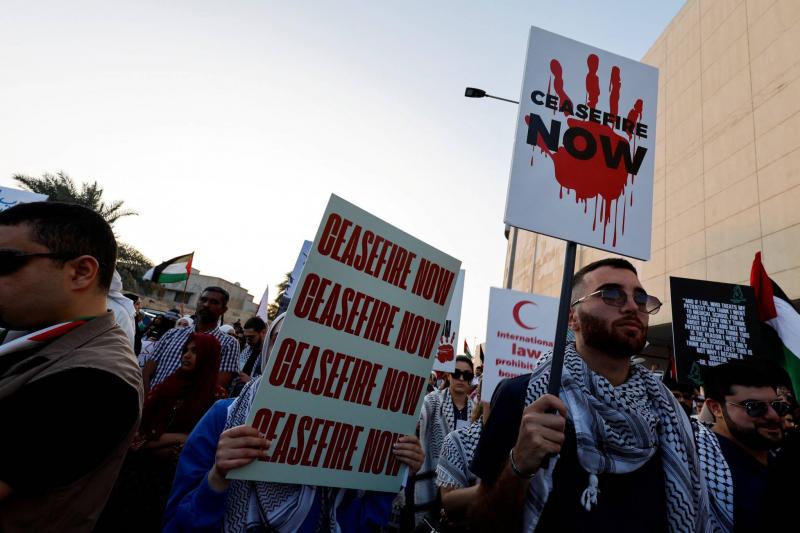The famous Palestinian headscarf "kufiya," known for its black and white colors, has become a symbol of solidarity with the Palestinian cause worldwide amid the escalating war between Israel and Hamas fighters in Gaza. However, it has turned into a problem for those who wear it. Supporters of Israel view the checkered scarf as provocative and consider it a sign of support for what they deem terrorism.
Thousands of people donned the kufiya during massive protests in Britain and elsewhere to express support for Palestinians and call for a ceasefire. However, activists state that police in France and Germany, which suppress pro-Palestinian protests, have warned or imposed fines or detained people wearing it.
Rami Al-Ashiq, a poet of Palestinian and Syrian descent living in Berlin, believes he has found a way to overcome this issue. He has tattooed the design of the kufiya on his forearm. He told Reuters while the tattoo artist was putting the finishing touches on her work, “I am celebrating my anger and my culture that is being criminalized. It is beautiful too, and reminds us never to forget this large number of people who have been killed.”
However, the German newspaper Süddeutsche Zeitung described the kufiya as a "fabric of contention" and suggested that pro-Palestinian German protesters wear Nazi attire instead. In this charged atmosphere, acts of violence have occurred. Last month in Vermont, USA, three Palestinian-American university students were shot, two of whom were wearing the kufiya, resulting in one sustaining paralysis.
### A Symbol of Revolution
The kufiya has long been a symbol of Palestinian nationalism, embodied by the late Palestinian Liberation Organization leader Yasser Arafat, who was rarely photographed without it. He would fold it in a way that depicted the shape of historic Palestine. Design historian Anu Lingala told Reuters that the cloth gained political significance for the first time during the revolution against British rule from 1936 to 1939 when rural fighters covered their faces with it, demonstrating "unified resistance."
The white and black pattern emerged in the 1950s when British General John Glubb designated it for Palestinian soldiers in the Arab Legion to distinguish them from Jordanian soldiers who wore red and white. This is detailed in the book "Memories of the Revolution" by American historian Ted Swedenburg. Later, it was worn by Palestinian fighters, such as Leila Khaled, who hijacked an American TWA plane in 1969. Anti-apartheid South African leader Nelson Mandela, whose African National Congress was close to the PLO, occasionally wore the kufiya.
With the ban on raising the Palestinian flag in the West Bank and Gaza occupied by Israel from 1967 to 1993, the kufiya became a symbol of the struggle for a Palestinian state. Poet Rami Al-Ashiq noted that “what was used to cover the identity of anti-British colonial rebels has now become a symbol to display that identity.”
### Rising Demand for the Kufiya
Since the beginning of the Israeli invasion of Gaza, online orders for the kufiya have surged on the website of the Harbawi factory, the last kufiya manufacturer in the Palestinian territories. Nael Qasis, the company's European partner, told Reuters that their monthly production capacity of 5,000 kufiyas means it will take years to meet the accumulated orders from 150,000 people interested in the kufiya.
Loui Hayatla, a seller at one of the Eastern ornaments shops in Berlin, stated that the Gaza war has led to a 200 percent increase in demand. Hayatla, whose shop attracted police attention due to the Palestinian flag hanging in the window, said, “We had to receive two air shipments from Syria.”
Berlin and Paris police have stated that wearing the kufiya is not illegal unless it covers the face. However, Berlin police indicated that they could impose restrictions or ban outdoor gatherings if they believe public safety is at serious risk, which could include banning the kufiya.
Paris police declined to comment on specific cases. Police stopped Ghassan Mazoughi while he was leaving a march in Paris in November. Mazoughi was asked to remove the red kufiya he was draping over his shoulders. The 39-year-old computer programmer stated, "They were calm, but the message was clear… take it off, or you won’t leave."
The police asked scientist Ysra Masari, 44, to remove her scarf while riding the Paris metro. When she refused, she was fined 30 euros for organizing an unauthorized protest. She said, "I was shocked and cried tears. It is a symbol, and this is the least we can do."




